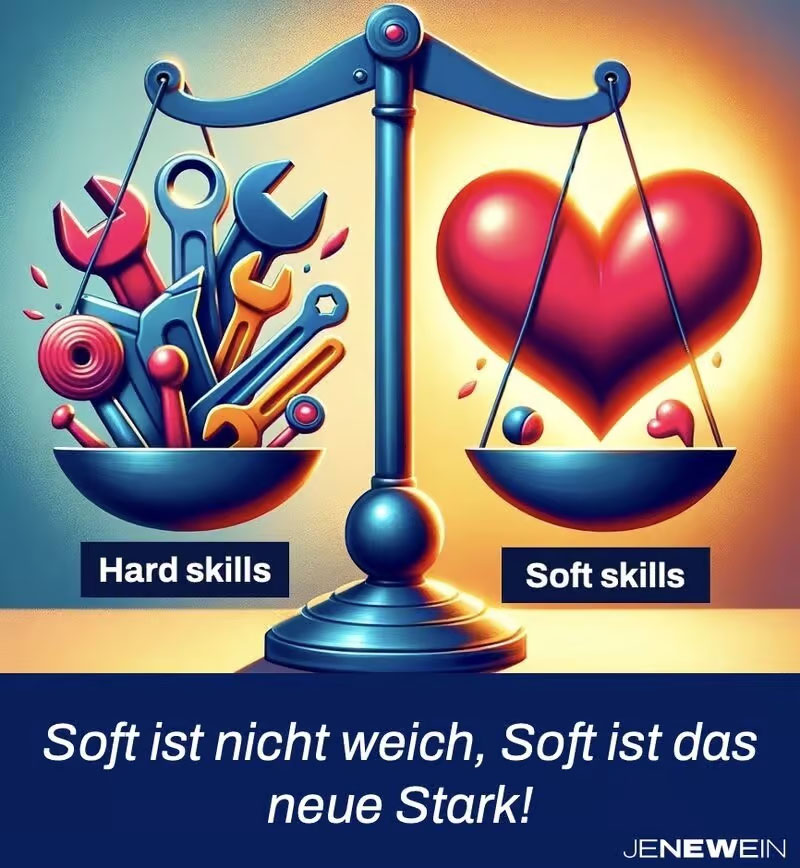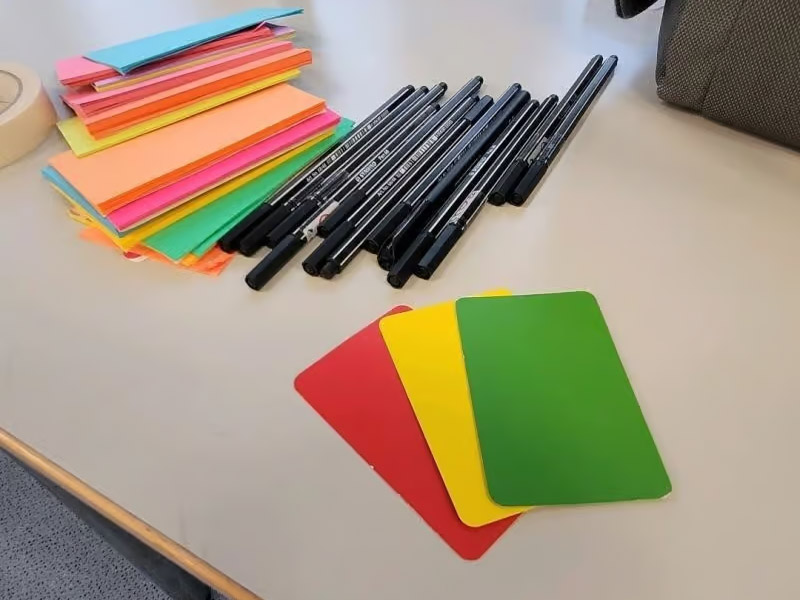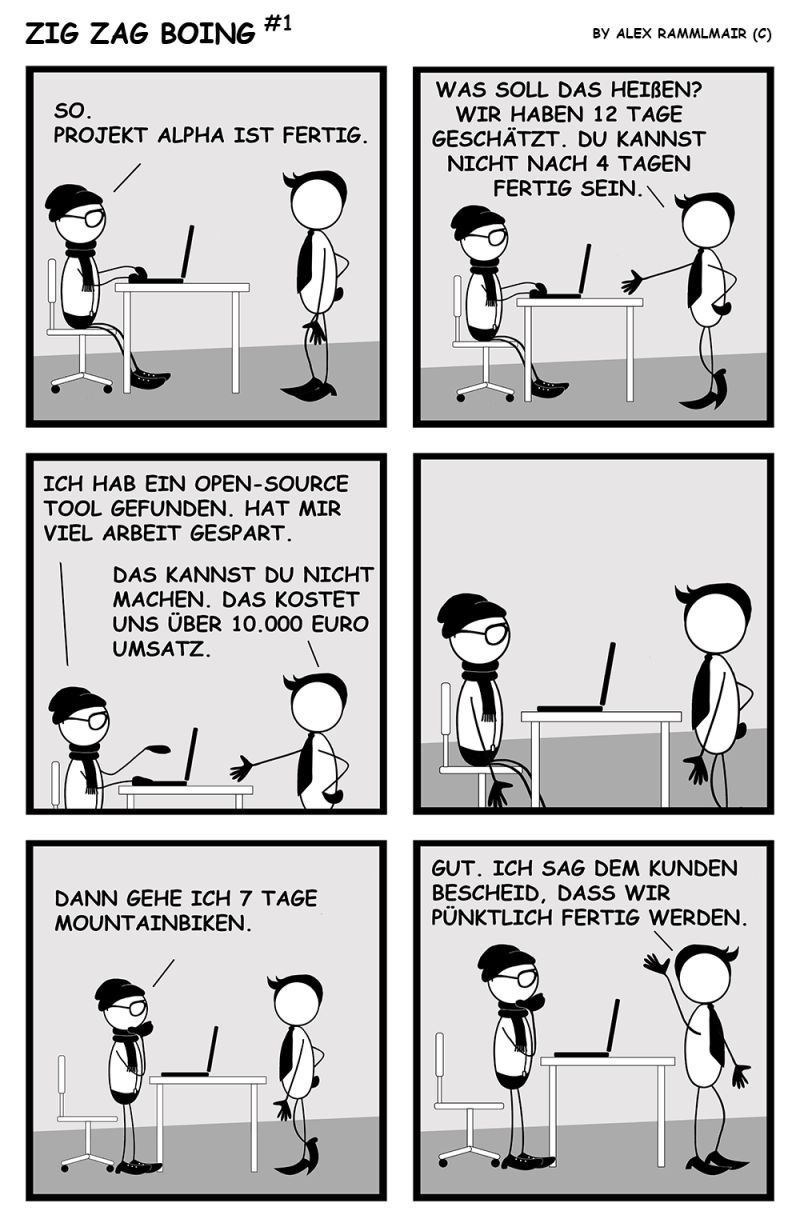Impulses for organisations – Part 8
In the flood of posts on social media platforms, there are always little treasures that address people in organisations and provide tips and tricks or special perspectives on individual aspects of collaboration. However, many of these treasures disappear into the depths of the platforms, never to be seen again. In part 8 of our series, I would also like to “showcase” individual impulses from experts in the t2informatik Blog. This time it’s about soft skills, traffic light cards, leading and following, mountain biking and the problem of developing too quickly.
Let’s get started with the new impulses!
Soft skills or human skills
I still often encounter the prejudice that soft skills are not really important. They are not tangible, not controllable and that is why we should not devote too much attention to this topic. As the name suggests, soft is soft and for many people soft is still synonymous with weak and weak doesn’t get us anywhere in these tough times. What we need are hard facts, clear plans and tough announcements! Not really 😉
For all those who still think this way, a categorisation of the terms: In the 1960s, psychologists in the US military had the task of working out the factors for a successful mission. It was assumed that, in addition to the handling of tanks and weapons, leadership, empathy and cooperation were also crucial for a troop to excel and return home safely. Unfortunately, the unfortunate decision was made at the time to label all weapons-related skills as “hard skills”. Simply because these activities required the handling of steel. In contrast, emotional and social skills were labelled “soft skills”. Later, psychologists recommended changing the terminology, as a skill that is labelled soft can be associated with being weak, but soldiers want to be strong and confident (cf. Grant 2023).
By then, however, it was already too late, the term was out in the world and the prejudices persist to this day. In many companies, the HR department is still ridiculed and seen as a necessary evil rather than a real asset. Leadership and culture development programmes are still recognised as folklore rather than a real differentiating factor. And just recently, I was once again greeted at a workshop with the words: “Is this one of those tree-hugging seminars?”
Yes, indeed, there are HR departments that do more harm than good. And there are also rubbish coaching sessions. But we shouldn’t let that confuse us. By now, we should all know that our character and cohesion are our greatest strengths. If our cognitive abilities set us apart from animals, then our social and emotional abilities set us apart from machines. In an age where AI can drive cars, write texts and operate humans, the skills that make us human are more important than ever.
Soft skills quickly become hard facts in organisations if we don’t actively consider and promote them. As machines take over more and more of our lives, the remaining human interactions will become increasingly important.
So soft is not soft. On the contrary, it’s the new strong!
How do you see this? And what word do you think we could use to replace the unfortunate term “soft skills”? My favourite would be “human skills”.
Discussing and deciding more effectively with traffic light cards
“Kai, can we keep the cards afterwards?”
I don’t hear that very often. A central challenge for me in a moderation is always to provide space for all important points of view in the discussion on the one hand, and to reach decisions quickly and clearly on the other. Over time, these playing cards in traffic light colours have developed into a little secret weapon: they can be taken anywhere, work well in larger groups and, above all, are understood quickly and intuitively – important when you often have to deal with new customers and teams.
During an ongoing discussion, people can use them to indicate different requests to speak:
- green = I agree
- yellow = my own view
- red = I have an objection
For decisions, they provide a quick way to query consensus: green stands for agreement, yellow would like to get something out of the way, red indicates objection/veto. The whole thing also works remotely and requires considerably less explanation than a Fist to Five, for example, especially as the fine gradation with five different answers is unnecessary for most issues anyway.
For me, the best indication of its usefulness is that customer teams often want to use it themselves after the first appointment – even in more traditional contexts. In any case, I now have them with me everywhere.
PS: One more thought for people who might be colour-blind, for example: the cards could easily be supplemented with additional symbols, e.g. a thumbs-up, an exclamation mark or a stop sign – even spontaneously using a marker if necessary. However, I haven’t had the demand for this yet.
Leading and following – the game only works in pairs
Have you ever heard the question: What qualities should a good leader have? The question already trivialises the phenomenon of #leadership.
1️⃣ Entity vs. process thinking
In our western society, we are primarily conditioned to one type of thinking, analytical #thinking. We break problems down into sub-problems, solve these sub-problems and combine the partial solutions in a linear fashion to form a solution. We are therefore born with what is known as entity thinking. We have built organisations such as schools, companies, universities etc. according to this pattern.
What is lost in entity thinking? Relationships, e.g. the #process of leadership, and therefore #complexity. Complexity lies in the relationship between entities. This can be recognised in our world. Complexity in the world has only increased massively with increasing networking, not with the growing population.
Entity thinking also allows us to categorise the question of the characteristics of a good leader as relevant, which it is not.
2️⃣ Observing relationships
So if you want to look for factors of success in leadership, you should observe relationships and thus processes. And this makes #following as a competence just as important as #leading. However, little is said about this.
Here is an example in the context of #power.
If I focus my observation on the relationship between two people, I can observe power relationships, regardless of what both sides contribute, because I cannot easily observe this in #behaviour. One side could, for example, act submissively and thus cede power to the other side. But the side that acts submissively can also use so much power that it ascribes power to the other side in the first place.
We will probably never find out: all we can observe is the dynamics of the relationship, not what each side contributes to it.
3️⃣ Appropriate observation of leadership
With process thinking, phenomena in the context of leadership present themselves quite differently, in my view more appropriately than if we were to think in terms of entities, which ultimately allows us to arrive at more appropriate solutions.
The game only works in pairs and because it only works in pairs, relationships not only play a role, they drive complexity. If we focus on individual people in our observations, we destroy relationships and therefore complexity and the problem we want to solve.
By focusing on relationships when we observe leadership, we release people into #freedom, whereupon they can take #responsibility in the first place, because they are not labelled. This way of observing and acting makes leadership more people-centred.
You are welcome to try it out: It works.
7 days of mountain biking
What do you do when you realise that you are actually much faster than estimated?
- Do you actually pass the advantage on to the customer and forgo the money?
- Do you prefer to say nothing and finish “on time”?
- Or do you use the free time to compensate for another project that takes longer than planned?
None of the options feel really good, do they?
Value pricing instead of hourly billing saves you such dilemmas.
Impulses and questions
Four different topics, four people with different ideas and approaches, four individual impulses. What do we associate with the term soft skills and which term might be better suited to describe the important skills in working together? How can we structure discussions and make better consensus-based decisions? How can we sensibly change perspectives in our work context? Why does it make sense to observe relationships between people and thus make leadership more people-centred? And what do organisations do to put themselves at a disadvantage when they deliver services faster?
Questions upon questions. Perhaps you also have one or two; great! Then Part 8 of “Impulses for organisations” has also achieved its goal.
Notes:
If you like this article or would like to discuss it, please feel free to share it with your network.
[1] Wolfgang Jenewein is a professor at the University of St. Gallen, founder of Jenewein AG, leadership expert and speaker. Information about Wolfgang Jenewein can be found in his LinkedIn profile, here you can find the original impulse on LinkedIn.
[2] Kai-Marian Pukall works as a organisational consultant for Seibert Media GmbH. He has been supporting agile teams for many years, always with the aim of making collaboration valuable and professional, simple and people-friendly. Information about Kai-Marian Pukall can be found in his LinkedIn profile, here you can find the original impulse on LinkedIn.
Kai-Marian Pukall has published several articles on the t2informatik Blog.
[3] Conny Dethloff works as an organisational designer for emergize GmbH & Co. KG and helps people in organisations to find and establish suitable structures and processes in the context of value generation. Information about Conny Dethloff can be found in his LinkedIn profile, here you can find the original impulse on LinkedIn.
You can also find posts by Conny Dethloff on the t2informatik Blog.
And you can also find posts by Alex Rammlmair on the t2informatik Blog.
Michael Schenkel has published further impulses in the t2informatik Blog, including

Michael Schenkel
Head of Marketing, t2informatik GmbH
Michael Schenkel has a heart for marketing - so it is fitting that he is responsible for marketing at t2informatik. He likes to blog, likes a change of perspective and tries to offer useful information - e.g. here in the blog - at a time when there is a lot of talk about people's decreasing attention span. If you feel like it, arrange to meet him for a coffee and a piece of cake; he will certainly look forward to it!





